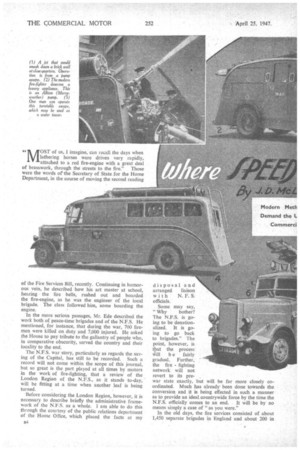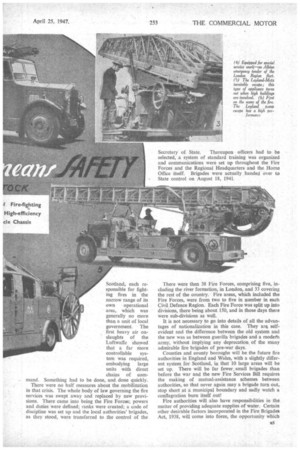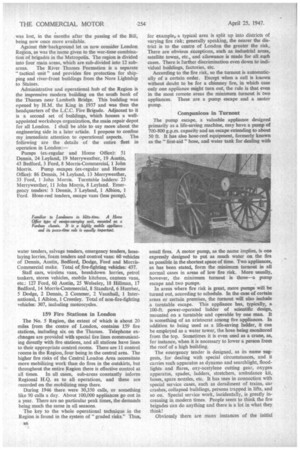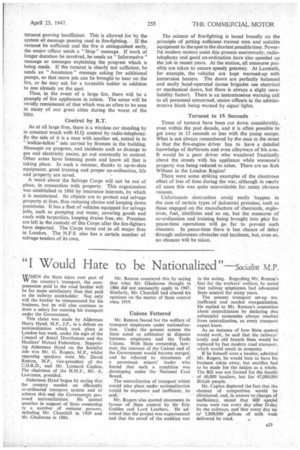lathering horses were driven very rapidly, attached to a red
Page 38

Page 39

Page 40

Page 43

If you've noticed an error in this article please click here to report it so we can fix it.
fire-engine with a great deal of brasswork, through the streets to the fire." Those were the words or the Secretary of State br the Home Department, in the course of moving the second reading
of the Fire Services Bill, recently. Continuing in humorous vein, he described how his art master at school, hearing the fire bells, rushed out and boarded the fire-engine, as he was the engineer of the local brigade. The class followed him, some boarding the engine.
In the more serious passages, Mr. Ede described the work both of peace-time brigades and of the N.F.S. He mentioned, for instance, that during the war, 700 firemen were killed on duty and 7,000 injured. He asked the House to pay tribute to the gallantry of people who, in comparative obscurity, served the country and their locality to the end.
The N.F.S. war story, particularly as regards the saving of the Capital, has still to be recorded. Such a record will not come within the scope of this journal, but so great is the part played at all times by motors in the work of fire-fighting, that a review of the London Region of the N.F.S., as it stands to-day, will be fitting at a time when another leaf is being turned.
Before considering the London Region, however, it is necessary to describe briefly the administrative framework of the N.F.S. as a whole. I am able to do this through the courtesy of the public relations department of the Home Office, which placed the facts at my B4 disposal and arranged liaison with N.F.S.
officials.
Some may say, why bother? The N.F.S. is going to be denationalized. It is going to go back to brigades." The point, however, is that the process will b e fairly gradual. Further, the fire fighting network will not revert to its pre war state exactly, but will be far more closely coordinated. Much has already been done towards the conversion and it is being effected in such a manner as to provide an ideal countrywide force by the time the N.F.S. officially comes to an end. It will be by no means simply a case of "as you were."
In the old days, the fire services consisted of about 1,450 separate brigades in England and about 200 in
Scotland, each responsible for fighting fires in the narrow range of its own operational area, which was generally no more than a unit of local government. The first heavy air onslaughts of the Luftwaffe showed that a far more controllable system was required, embodying large units with direct chains of command. Something had to be done, and done quickly.
There were no half measures about the mobilization in that crisis. The whole body of law governing the fire services was swept away and replaced by new provisions. There came into being the Fire Forces; powers and duties were defined; ranks were created; a code of discipline was set up and the local authorities' brigades, as they stood, were transferred to the control of the Secretary of State. Thereupon officers had to be selected, a system of standard training was organized and communications were set up throughout the Fire Forces and the Regional Headquarters and the Home Office itself. Brigades were actually handed over to State control on August 18, 1941.
There were then 38 Fire Forces, comprising five, including the river formation, in London, and 33 covering the rest of the country. • Fire areas, which included the Fire Forces, were from two to five in number in each Civil Defence Region. Each Fire Force was split up into divisions, there being about 150, and in those days there were sub-divisions as well.
It is not necessary to go into details of all the advantages of nationalization in this case. They are selfevident and the difference between the old system and the new was as between guerilla brigades and a =den army, without implying any deprecation of the many admirable fire brigades of pre-war days.
Counties and county boroughs will be the future fire authorities in England and Wales, with a slightly different system for Scotland, in that 10 large areas will be set up. There will be far fewer, small brigades than before the war and the new Fire Services Bill requires the making of mutual-assistance schemes between authorities, so that never again may a brigade turn out, stop short at a municipal boundary and sadly watch a conflagration burn itself out!
Fire authorities will also have responsibilities in the matter of providing adequate supplies of water. Certain other desirable factors incorporated in the Fire Brigades Act, 1938, will come into force, the opportunity which was lost, in the months after the passing of the Bill, being now once more available.
Against this background let us now consider London Region, as was the name given to the war-time combination of brigades in the Metropolis. The region is divided into four main areas, which are sub-divided into 12 subareas. The River Thames Formation is a separate " tactical unit" and provides fire protection for shipping and river-front buildings from the Nore Lightship to Staines.
Administrative and operational hub of the Region is the impressive modem building on the south bank of the Thames near Lambeth Bridge. This building was opened by H.M. the King in 1937 and was then the headquarters of the L.C.C. Fire Brigade. Adjacent to it is a second set of buildings, which houses a wellappointed workshops organization, the main repair depot for all London. I shall be able to say more about the engineering side in a later article. I propose to confine my immediate attention to operational aspects. The following are the details of the entire fleet in operation in London:— Pumps (ex-regular and Home Office): 51 Dennis, 24 Leyland, 19 Merryweather, 19 Austin, 43 Bedford, 3 Ford, 8 Morris-Commercial, 1 John Morris. Pump escapes (ex-regular and Home Office): 86 Dennis, 34 Leyland, 13 Merryweather, 33 Ford, 1 John Morris. Turntable ladders: 23 Merryweather, 11 John Morris, 8 Leyland. Emergency tenders: 3 Dennis, 3 Leyland, 1 Albion, 1 Ford. Hose-reel tenders, escape vans (less pump), water tenders, salvage tenders, emergency tenders, hoselaying lorries, foam tenders and control vans: 60 vehicles of Dennis, Austin, Bedford, Dodge, Ford and MorrisCommercial make. Total of fire-fighting vehicles: 437.
Staff cars, wireless vans, breakdown lorries, petrol tankers, stores vehicles, mobile kitchens, canteen vans, etc.: 127 Ford, 60 Austin, 25 Wolseley, 18 Hillman, 17 Bedford, 14 Morris-Commercial, 8 Standard, 6 Humber, 5 Dodge, 2 Dennis, 2 Commer, 2 Vauxhall, I International, 1 Albion, 1 Crossley. Total of non-fire-fighting vehicles: 307, including motorcycles.
159 Fire Stations in London The No 5 Region, the extent of which is about 20 miles from the centre of London, contains 159 fire stations, including six on the Thames. Telephone exchanges are provided with special fire lines communicating directly with fire stations, and all stations have lines to their appropriate control rooms. There are 11 control rooms in the Region, four being in the central area. The higher fire risks of the Central London Area necessitate more mobilizing work than do fires in the outskirts, but throughout the entire Region there is effective control at all times. In all cases, sub-areas constantly inform Regional H.Q. as to all operations, and these are recorded on the mobilizing map there.
During 1946 there were 30,350 calls, or something like 90 calls a day. About 100,000 appliances go out in a year. There are no particular peak times, the demands being much the same in all seasons.
The key to the whole operational technique in the Region is found in the system of "graded risks." Thus, for example, a typical area is split up into districts of varying fire risk; generally speaking, the nearer the district is to the centre of London the greater the risk, There are obvious exceptions, such as industrial areas, satellite towns, etc. and allowance is made for all such cases. There is further discrimination even down to individual buildings, factories, etc.
According to the fire risk, so the turnout is automatically of a certain order. Except when a call is known without doubt to be for a chimney fire, in which case only one appliance might turn out, the rule is that even in the most remote areas the minimum turnout is two appliances. These are a pump escape and a motor pump.
Companions in Turnout The pump escape, a valuable appliance designed primarily as a life-saving machine, may have a pump of 700-800 g.p.m. capacity and an escape extending to about 50 ft. It has also hose-reel equipment, formerly known as the " first-aid " hose, and water tank for dealing with small fires. A motor pump, as the name implies, is one expressly designed to put as much water on the fire as possible in the shortest space of time. Two appliances, as has been stated, form the minimum turnout in all normal cases in areas of low fire risk. More usually, however, the minimum turnout is three a pump escape and two pumps.
In areas where fire risk is great, more pumps will be turned out, according to schedule. In the case of certain areas or certain premises, the turnout will also include a turntable escape. This appliance has, typically, a 100-ft. power-operated ladder of scientific design, mounted on a turntable and operable by one man. It is something of an aristocrat among fire appliances. In addition to being used as a life-saving ladder, it can be employed as a water tower, the hose being monitored from the top. Sometimes it is even used as a crane, as, for instance, when it is necessary to lower a person from the roof of a high building.
The emergency tender is designed, as its name suggests, for dealing with special circumstances, and it carries such apparatus as dynamo and searchlight, floodlights and flares, oxy-acetylene cutting gear, oxygen apparatus, spades, ladders, stretchers, ambulance kit, hoses, spare nozzles, etc. It has uses in connection with special service cases, such as derailment of trains, car crashes, collapsed buildings, persons trapped in lifts, and so on. Special service work, incidentally, is greatly increasing in modern times. People seem to think the fire brigades can do anything and there is a lot in what they think!
Obviously there are many instances of the initial turnout proving insufficient. This is allowed for by the system of message passing used in fire-fighting. If the turnout be sufficient and the fire is extinguished early, the senior officer sends a " Stop " message. If work of longer duration be involved, he sends an " Informative " message or messages explaining the progress which is being made. If the turnout is clearly not sufficient, he sends an " Assistance " message asking for additional pumps, so that more jets can be brought to bear on the fire, or he may ask for a turntable ladder in addition to one already on the spot.
Thus, in the event of a large fire, there will be a panoply of fire appliances in action. The scene will be vividly reminiscent of that which was so often to be seen in many of our great cities during the worst of the blitz.
Control by R.T.
As at all large fires, there is a wireless car standing by in constant touch with H.Q. control by radio-telephony. By the side of it is a man with another set, netted in to " walkie-talkie " sets carried by firemen in the building. Messages on progress, and incidents such as damage to gas and electricity mains, go out constantly to control. Other areas have listening posts and know all that is taking place. In such a manner, thanks to up-to-date equipment, good training and proper co-ordination, life and property are saved.
A word about the Salvage Corps will not be out of place, in connection with property. This organization was established in 1866 by insurance interests, by which it is maintained. Its objects are to protect and salvage property at fires, thus reducing claims and keeping down premiums. It has a. fleet of vehicles equipped for salvage jobs, such as pumping out water, covering goods and roofs with tarpaulins, keeping drains free, etc. Premises are left in the custody of this Corps after the fire-fighters have departed. The Corps turns out to all major fires in London. The N.F.S also has a certain number of salvage tenders of its own. The science of fire-fighting is based broadly on the principle of getting sufficient trained men and suitable equipment to the spot in the shortest possible time. Powerful modern motors assist this process enormously; radiotelephony and good co-ordination have also speeded up the job in recent years. At the station, all measures possible are taken to ensure speedy getaway. At Lambeth, for example, the vehicles are kept warmed-up with immersion heaters. The doors are perfectly balanced and easily hand-operated (some brigades use electrical or mechanical doors, but there is always a slight unreliability factor). There is an instantaneous warning call to all personnel concerned, senior officers in the administrative block being warned by signal lights.
Turnout in 15 Seconds
Times of turnout have been cut down considerably, even within the past decade, and it is often possible to get away in 15 seconds or less with the pump escape. What is not always remembered by the man in the street is that the fire-engine driver has to have a detailed knowledge of thewStreets and even alleyways of his area. It would be a poor driver who wandered frantically about the streets with his appliance while someone's property was being reduced to ashes. There are no Rob Wiltons in the London Region!
There were some striking examples of the disastrous effect of loss of time during the war, although in nearly all cases this was quite unavoidable for many obvious reasons.
Unfortunate destruction could easily happen in the case of certain types of industrial premises, such as those engaged on the manufacture of chemicals, explosives, fuel, distillates and so on, but the measures of co-ordination and training being brought into play for peace-time operations will go far to prevent such disasters. In peace-time there is less chance of delay through unforeseen obstacles and incidents, but, even so, no chances will be taken.












































































